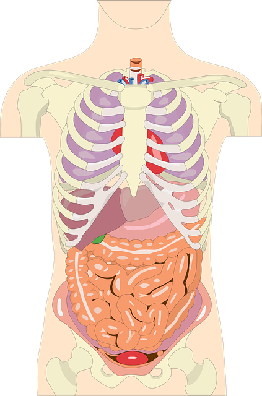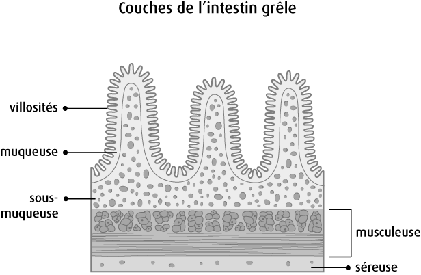Nous avons le plaisir de vous présenter un article invité qui a été rédigé par Sandrine Chalou, naturopathe. Pour son entrée dans Santé Nutrition Mag, elle nous parle de l’intestin et du dilemme qu’il représente.
Peut-être pensez-vous encore que l’intestin n’est qu’un vulgaire système de tuyauterie qui permet de transporter nos aliments ? Ce serait bien mal considérer cet organe.
Les dernières recherches ont montré que cet organe est sensible et intelligent.
Il est capable d’influencer secrètement :
- Notre sommeil
- Notre mémoire
- Nos humeurs
- Et voire même notre personnalité!
Sauf que voilà, notre bel organe est confronté à un vrai dilemme.
Il joue deux rôles a priori antagonistes :
- un rôle d’assimilation
- un rôle de barrière protectrice
Pour mieux comprendre

La digestion commence dans notre bouche par la mastication, qui permet de fragmenter les aliments et de débuter la digestion grâce à des enzymes comme l’amylase salivaire.
Une fois avalés, les aliments descendent dans l’œsophage qui va déboucher dans l’estomac par l’intermédiaire du sphincter œsophagien. Le sphincter se relâchant va permettre le passage des aliments dans l’estomac.
Lorsque la nourriture mastiquée arrive dans l’estomac, un véritable malaxage va être mis en œuvre grâce aux muscles lisses. Les glandes gastriques sécrètent de l’acide chlorhydrique (il faut savoir que le PH de l’estomac = 2) et des enzymes, qui sont des ciseaux très spécialisés, qui permettent la dégradation les macronutriments que sont les glucides, les protéines et les lipides.
L’estomac se charge donc de pétrir les aliments et de découper encore plus notre bol alimentaire. Le contenu de l’estomac passe alors au niveau du pylore, à l’extrémité inférieure de l’estomac pour déboucher dans notre intestin grêle au niveau du duodénum.
En fait, c’est bien l’intestin qui est le principal organe de la digestion : c’est au niveau de l’intestin grêle que les nutriments sont absorbés et passent dans la circulation sanguine, pour être distribués à l’organisme. Tout ce qui va être intéressant pour l’organisme sera assimilé à ce niveau.
Les parties non assimilées au niveau de l’intestin comme la cellulose des légumes par exemple vont constituer des déchets et progresser lentement dans le gros intestin pour former les selles. C’est au niveau du gros intestin que vont être assimilés l’eau, le sodium et le potassium.
Pour terminer, les déchets vont arriver au niveau du rectum pour être éliminés.
Une merveille de technologie
Vous connaissez les club sandwichs ? Et bien considérez que la muqueuse intestinale est comme un club sandwich, composée de différentes couches.

Dans sa partie supérieure, on va retrouver les villosités : ce sont des petits cils vibratiles qui constituent un jeu de plis et replis. Un peu comme le mouvement des algues dans la mer. On a ainsi un jeu de creux et de bosses couvertes de cellules que l’on appelle entérocytes.
Nos entérocytes côté mode sont restés bloqués dans les années 80 : elles sont coiffées en brosse !
Et encore mieux : chaque cheveu de la brosse est pourvu à son sommet d’autres de microvillosités, plus de 2000 par cheveu, ce qui multiplie considérablement la surface d’absorption.
Nous possédons ainsi un tube qui mesure de 6 à 8 mètres mais dont la surface est organisée de telle manière que sa surface, si elle était dépliée, équivaudrait à la surface d’un terrain de tennis !
Les cellules de l’intestin se plaisent à être collées entre elles : c’est le complexe de jonctions serrées. Elles constituent ainsi une barrière protectrice, une frontière entre le monde extérieur et l’intérieur de l’organisme. C’est ainsi que seuls les éléments “autorisés” (vitamines, minéraux, acides aminés de petite taille,…etc.) sont habilités à passer selon des protocoles biochimiques bien précis.
Certaines de ces cellules sont des cellules endocrines : c’est-à-dire qu’elles vont sécréter des messagers chimiques. Ce sont des hormones qui vont aussi circuler dans les couches inférieures de notre club sandwich.
A titre d’exemple, la sérotonine, l’hormone du bonheur, est produite à 90% dans l’intestin. On voit déjà se tisser les liens entre intestin et humeur.
Au niveau intermédiaire, on va retrouver le tissu conjonctif de la sous-muqueuse constitué des cellules immunitaires. Il faut savoir que 80 % de notre immunité se situe à ce niveau. C’est dire le lien étroit en intestin et immunité !
Enfin on retrouve tout en bas, des vaisseaux sanguins et lymphatiques. Les éléments qui ont été autorisés à passer vont emprunter ces voies d’absorption et ainsi passer dans le milieu intérieur. Mais on retrouve également à ce niveau des neurones. Il faut savoir que 200 millions de neurones tapissent notre intestin, soit l’équivalent du cortex d’un chat ! A ce stade, vous devriez déjà voir votre intestin sous un autre jour.
Les éléments « autorisés » à passer la barrière intestinale vont ainsi
- traverser les entérocytes,
- agir sur les cellules immunitaires
- activer les cellules endocrines et libérer des hormones.
- Et faire passer des messages chimiques dans le sang mais aussi au niveau des neurones du système entérique et remonter jusqu’au cerveau grâce à un nerf, plus connu sous nerf vague.
Vous l’aurez compris, l’intestin a une action sur le cerveau, le système immunitaire ainsi que sur tous les tissus et organes.
On comprend mieux l’enjeu qui constitue un vrai dilemme pour l’intestin :
- il doit à la fois permettre l’assimilation en laissant passer les bons nutriments
- mais il doit à la fois jouer un rôle de protection, en empêchant les éléments indésirables de passer dans l’organisme.
Il apparaît donc primordial de reconsidérer et prendre soin de cet organe souvent mal aimé car il est désormais central dans l’apparition des maladies, notamment les maladies dites de civilisation.



